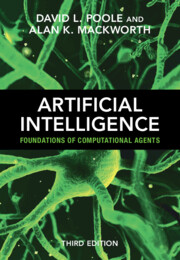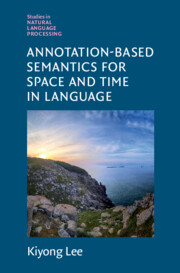Refine search
Actions for selected content:
3312 results in Artificial Intelligence and Natural Language Processing

Artificial Intelligence
- Foundations of Computational Agents
-
- Published online:
- 14 August 2023
- Print publication:
- 13 July 2023
-
- Textbook
- Export citation
Toward a shallow discourse parser for Turkish
-
- Journal:
- Natural Language Engineering / Volume 30 / Issue 5 / September 2024
- Published online by Cambridge University Press:
- 11 August 2023, pp. 1009-1034
-
- Article
-
- You have access
- Open access
- HTML
- Export citation
How you describe procurement calls matters: Predicting outcome of public procurement using call descriptions
-
- Journal:
- Natural Language Engineering / Volume 30 / Issue 6 / November 2024
- Published online by Cambridge University Press:
- 10 August 2023, pp. 1255-1276
-
- Article
-
- You have access
- Open access
- HTML
- Export citation
Emojis as anchors to detect Arabic offensive language and hate speech
-
- Journal:
- Natural Language Engineering / Volume 29 / Issue 6 / November 2023
- Published online by Cambridge University Press:
- 10 August 2023, pp. 1436-1457
-
- Article
-
- You have access
- Open access
- HTML
- Export citation

Annotation-Based Semantics for Space and Time in Language
-
- Published online:
- 05 August 2023
- Print publication:
- 29 June 2023
SSL-GAN-RoBERTa: A robust semi-supervised model for detecting Anti-Asian COVID-19 hate speech on social media
-
- Journal:
- Natural Language Engineering / Volume 30 / Issue 6 / November 2024
- Published online by Cambridge University Press:
- 03 August 2023, pp. 1161-1180
-
- Article
-
- You have access
- Open access
- HTML
- Export citation
Masked transformer through knowledge distillation for unsupervised text style transfer
-
- Journal:
- Natural Language Engineering / Volume 30 / Issue 5 / September 2024
- Published online by Cambridge University Press:
- 25 July 2023, pp. 973-1008
-
- Article
-
- You have access
- Open access
- HTML
- Export citation
Navigating the text generation revolution: Traditional data-to-text NLG companies and the rise of ChatGPT
-
- Journal:
- Natural Language Engineering / Volume 29 / Issue 4 / July 2023
- Published online by Cambridge University Press:
- 19 July 2023, pp. 1188-1197
-
- Article
-
- You have access
- Open access
- HTML
- Export citation
Describe the house and I will tell you the price: House price prediction with textual description data
-
- Journal:
- Natural Language Engineering / Volume 30 / Issue 4 / July 2024
- Published online by Cambridge University Press:
- 18 July 2023, pp. 661-695
-
- Article
-
- You have access
- Open access
- HTML
- Export citation
Assessment of the E3C corpus for the recognition of disorders in clinical texts
-
- Journal:
- Natural Language Engineering / Volume 30 / Issue 4 / July 2024
- Published online by Cambridge University Press:
- 18 July 2023, pp. 851-869
-
- Article
-
- You have access
- Open access
- HTML
- Export citation
Chapter 9 - Reasoning with Uncertainty
- from Part III - Learning and Reasoning with Uncertainty
-
- Book:
- Artificial Intelligence
- Published online:
- 14 August 2023
- Print publication:
- 13 July 2023, pp 375-458
-
- Chapter
- Export citation
Reviews
-
- Book:
- Artificial Intelligence
- Published online:
- 14 August 2023
- Print publication:
- 13 July 2023, pp ii-iv
-
- Chapter
- Export citation
Chapter 3 - Searching for Solutions
- from Part II - Reasoning and Planning with Certainty
-
- Book:
- Artificial Intelligence
- Published online:
- 14 August 2023
- Print publication:
- 13 July 2023, pp 79-126
-
- Chapter
- Export citation
Chapter 12 - Planning with Uncertainty
- from Part IV - Planning and Acting with Uncertainty
-
- Book:
- Artificial Intelligence
- Published online:
- 14 August 2023
- Print publication:
- 13 July 2023, pp 517-582
-
- Chapter
- Export citation
Part IV - Planning and Acting with Uncertainty
-
- Book:
- Artificial Intelligence
- Published online:
- 14 August 2023
- Print publication:
- 13 July 2023, pp 515-642
-
- Chapter
- Export citation
Chapter 2 - Agent Architectures and Hierarchical Control
- from Part I - Agents in the World
-
- Book:
- Artificial Intelligence
- Published online:
- 14 August 2023
- Print publication:
- 13 July 2023, pp 51-76
-
- Chapter
- Export citation
Part I - Agents in the World
-
- Book:
- Artificial Intelligence
- Published online:
- 14 August 2023
- Print publication:
- 13 July 2023, pp 1-76
-
- Chapter
- Export citation
Chapter 8 - Neural Networks and Deep Learning
- from Part III - Learning and Reasoning with Uncertainty
-
- Book:
- Artificial Intelligence
- Published online:
- 14 August 2023
- Print publication:
- 13 July 2023, pp 327-374
-
- Chapter
- Export citation
Index of Algorithms
-
- Book:
- Artificial Intelligence
- Published online:
- 14 August 2023
- Print publication:
- 13 July 2023, pp 843-845
-
- Chapter
- Export citation
References
-
- Book:
- Artificial Intelligence
- Published online:
- 14 August 2023
- Print publication:
- 13 July 2023, pp 807-842
-
- Chapter
- Export citation

